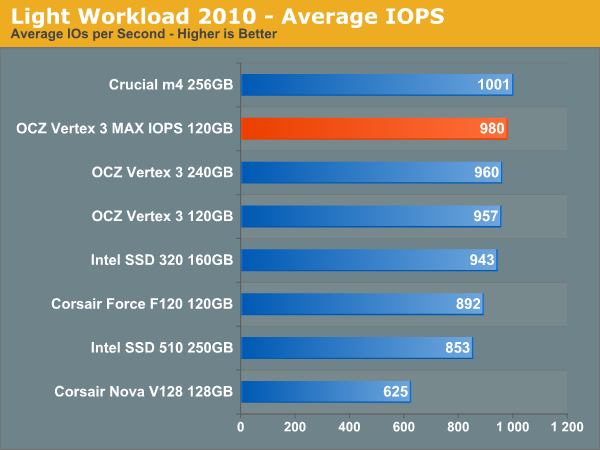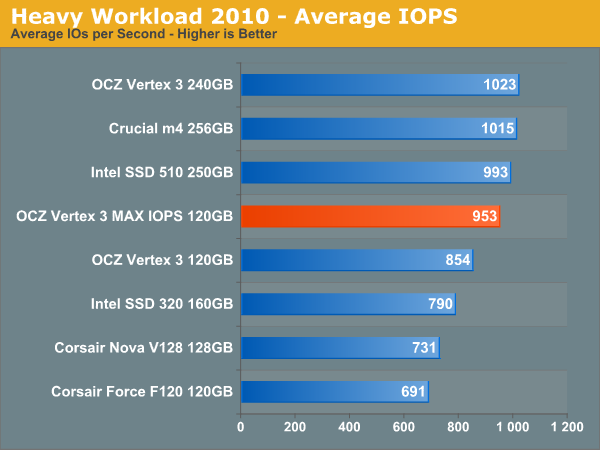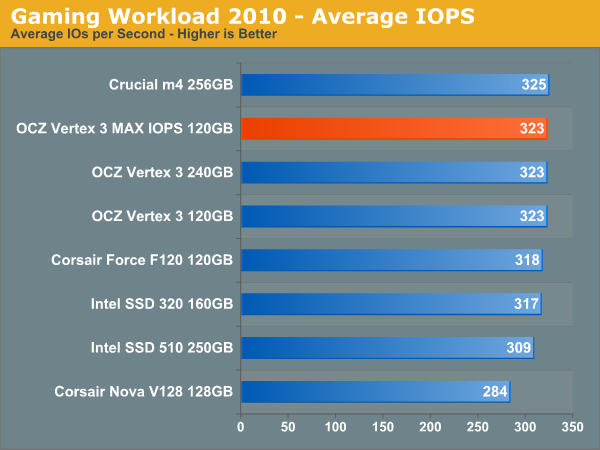OCZ Vertex 3 MAX IOPS & Patriot Wildfire SSDs Reviewed
by Anand Lal Shimpi on June 23, 2011 4:35 AM ESTAnandTech Storage Bench 2010
To keep things consistent we've also included our older Storage Bench. Note that the old storage test system doesn't have a SATA 6Gbps controller, so we only have one result for the 6Gbps drives.
The first in our benchmark suite is a light/typical usage case. The Windows 7 system is loaded with Firefox, Office 2007 and Adobe Reader among other applications. With Firefox we browse web pages like Facebook, AnandTech, Digg and other sites. Outlook is also running and we use it to check emails, create and send a message with a PDF attachment. Adobe Reader is used to view some PDFs. Excel 2007 is used to create a spreadsheet, graphs and save the document. The same goes for Word 2007. We open and step through a presentation in PowerPoint 2007 received as an email attachment before saving it to the desktop. Finally we watch a bit of a Firefly episode in Windows Media Player 11.
There’s some level of multitasking going on here but it’s not unreasonable by any means. Generally the application tasks proceed linearly, with the exception of things like web browsing which may happen in between one of the other tasks.
The recording is played back on all of our drives here today. Remember that we’re isolating disk performance, all we’re doing is playing back every single disk access that happened in that ~5 minute period of usage. The light workload is composed of 37,501 reads and 20,268 writes. Over 30% of the IOs are 4KB, 11% are 16KB, 22% are 32KB and approximately 13% are 64KB in size. Less than 30% of the operations are absolutely sequential in nature. Average queue depth is 6.09 IOs.
The performance results are reported in average I/O Operations per Second (IOPS):

If there’s a light usage case there’s bound to be a heavy one. In this test we have Microsoft Security Essentials running in the background with real time virus scanning enabled. We also perform a quick scan in the middle of the test. Firefox, Outlook, Excel, Word and Powerpoint are all used the same as they were in the light test. We add Photoshop CS4 to the mix, opening a bunch of 12MP images, editing them, then saving them as highly compressed JPGs for web publishing. Windows 7’s picture viewer is used to view a bunch of pictures on the hard drive. We use 7-zip to create and extract .7z archives. Downloading is also prominently featured in our heavy test; we download large files from the Internet during portions of the benchmark, as well as use uTorrent to grab a couple of torrents. Some of the applications in use are installed during the benchmark, Windows updates are also installed. Towards the end of the test we launch World of Warcraft, play for a few minutes, then delete the folder. This test also takes into account all of the disk accesses that happen while the OS is booting.
The benchmark is 22 minutes long and it consists of 128,895 read operations and 72,411 write operations. Roughly 44% of all IOs were sequential. Approximately 30% of all accesses were 4KB in size, 12% were 16KB in size, 14% were 32KB and 20% were 64KB. Average queue depth was 3.59.

The gaming workload is made up of 75,206 read operations and only 4,592 write operations. Only 20% of the accesses are 4KB in size, nearly 40% are 64KB and 20% are 32KB. A whopping 69% of the IOs are sequential, meaning this is predominantly a sequential read benchmark. The average queue depth is 7.76 IOs.











112 Comments
View All Comments
Chloiber - Thursday, June 23, 2011 - link
Hi Anand,is it possible to do the same (1 hour) torture tests for other SSDs such as Intel 320, Intel 510 and C300/m4? It would be interesting to see how the, in my opinion, huge performance hit with the Sandforce drives compares to other SSDs/controllers.
Impulses - Thursday, June 23, 2011 - link
I think he's done similar tests in past reviews, though probably not the very same 60 min test. Crucial drives had issues recovering from similar situations, and Intel drives were the most resilient (shocking right?). The SF drives are particularly susceptible to that sort of degradation when hammering them with incompressible data due to the very nature of how their compression algorithm works.That's one reason I've never been very high on SF drives... Currently I have two Intel drives being used as OS drives (where that sorta scenario is improbable), but if I decided to upgrade the desktop OS drive I could very well end up using one of those smaller drives as a scratch disk for working with video, or as a spare disk for game installs. SF wouldn't necessarily be ideally suited for that.
Chloiber - Friday, June 24, 2011 - link
Yes, but without the same 60mins the comparison is pretty much useless, sadly. You can see this very well in the Agility 3 review - nearly no performance drop with 20min torture test.I know that the SF drives drop performance to about 65% (write), both SF1 and SF2. And that it's not a state that you reach when you torture your drive is known because nearly everyone who does a ASS benchmark some month after the initial use show the lower performance (in case of SF2 that's 70-90MB/s seq. write).
But I'd like to see a direct comparison from Anand, would just be great.
And yes - that's also a reason why I won't buy SF drives. I just don't like it how they try to confuse customers. They say 450MB/s+ write...yeah right. In a very special case. And even worse, it drops down even more. Intel is honest about the performance of their SSD, that's what I like about it. But I'm pretty sure SF gained countless customers just because of those "incredible" performance stats.
Phil NBR - Thursday, June 23, 2011 - link
"So why not exclusively use real world performance tests? It turns out that although the move from a hard drive to a decent SSD is tremendous, finding differences between individual SSDs is harder to quantify in a single real world metric. "I don't think it's that hard. Sites like Hardwareheaven and Techspot show meaningful differences between SSDs in real world settings. I would like to see Anandtech include real real world benchmarks again. I/O bound benchmarks don't tell the whole story.
ckryan - Thursday, June 23, 2011 - link
It's my belief that these real world tests are contrived in and of themselves to some degree.Impulses - Thursday, June 23, 2011 - link
I don't frequent Hardware Heaven often but I do like the way they compare and present results for their GPU reviews, so I went looking for their "real world" SSD tests when I saw that comment. Out of the 5 or 6 tests like 3 or 4 are just large sequential read/write tests... Sure seeing 200 minutes vs 210 minutes might be somewhat more intuitive than a generic benchmark score, but it doesn't tell you a whole lot more tbh. It's all basically just OS/game install tests and file transfer/scan tests, with two exceptions...One is their OS boot up test, where the difference between all current drives is usually 2-3 sec at most (time to hibernate and resume might be more valuable imo), and the other is an HD video capture test that might actually be the only real world test they're doing of any actual value. It showcases the biggest disparity between the drives (due to sequential write speeds using raw uncompressed footage), and it really is something you could be doing day in and day out and not easily represented by synthetic benchmarks or some of the other test scenarios Anand uses. Worth looking into...
cjs150 - Thursday, June 23, 2011 - link
Seems to be a lot of conspiracy theorists about today.I read Anandtech because I do not detect bias. When it is wrong he will tell us. Sometimes I do not understand what he is saying - but that is because I am an amateur geek not a full time pro!
Now my noob question.
What is best way of setting up a system with an SSD and a traditional HD. Should I use the SSD for OS and programs and the HD for widows swap file. Or would it be fine to use the SSD for all OS functions? Happy to partition the HD so that there is a small partition for the OS swap
Impulses - Thursday, June 23, 2011 - link
Leave the swap file alone, Windows manages it just fine and a Windows engineer was quoted during the launch of Win7 as saying that SSD are particularly well suited for the swap file's purpose... If you have enough RAM it's gonna see little use besides background maintenance Windows does of active processes. Just install your OS and apps as you normally do on the SSD, let Win7 partition it (or Vista, if you're using XP you'll wanna look into proper partition alignment), and then use your HDD for large game installs that don't fit on the SSD and data.If you have lots of games at any one time it's worth looking into system links or junction links, they provide any easy way to move game directories to the SSD and back w/o altering or affecting the existing install (or w/o messing w/registry keys, it's like an OS level shortcut that's transparent to the programs).
If you have a small SSD (and particularly if you have lots of RAM), it's worth turning off hibernate as the hibernate file will take up a few GB of space on the drive (depending on the amount of RAM). Swap file should be dynamic and shouldn't grow too large if it's rarely used.
jwilliams4200 - Thursday, June 23, 2011 - link
Did I miss where you commented on the Desktop Iometer - 4KB Random Read chart?The 120GB Vertex 3 Max IOPS and the Patriot Wildfire were in the basement, with 35 MB/s or lower performance.
What is going on?
Anand Lal Shimpi - Thursday, June 23, 2011 - link
The 240GB Vertex 3 results were a typo, I've updated/corrected that entry. The Toshiba 32nm drives are even slower, likely due to the specific characteristics of that NAND vs. the IMFT devices.Random read performance is a weak area of many drives this generation for some reason. Even Crucial's m4 is slower than last year's C300 in this department.
Take care,
Anand